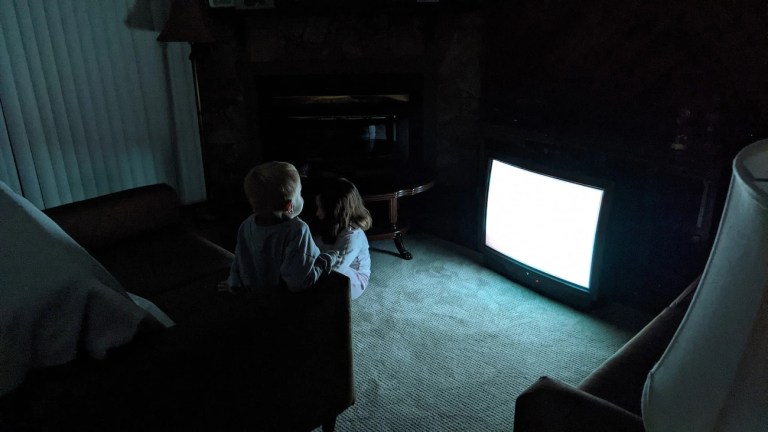Skinamarink Is the Strangest (and Most Original) Horror Movie You’ll See All Year
The most unlikely of cult horror curiosities, Skinamarink, comes to streaming—which may be the ideal place to experience this perversity.

The thing you should know about Skinamarink going in is that it’s a movie which does everything in its power to not be a movie. Call it an experience, call it an experiment, call it a nightmare simulator. Whatever it is, it’s unlike any movie you’ll see this year, skirting almost every cinematic convention you’ve ever heard about.
The actors’ faces, for example, are never shown. Virtually every shot seems to have no clear focus, with objects and subjects obscured or only partially in-frame, the camera seemingly misplaced and left on by mistake. Shots are often uncomfortably long and lingering, the image quality is oppressively lo-fi, and there’s no traditional soundtrack to speak of. On the surface, it’s almost as if the movie wasn’t meant to be watched by an audience at all. But Skinamarink, directed by Kyle Edward Ball in his feature debut, isn’t some weird-just-to-be-weird art project lacking any real substance; it’s a mesmerizing film that captures the nebulousness of fear with fractured storytelling that’s more about feeling than interpreting.
The story is about two young siblings, Kevin (Lucas Paul) and Kaylee (Dali Rose Tetreault), who are haunted by a monster in the shadows of their home when their parents—and the house’s doors and windows—mysteriously disappear. Filmed in Ball’s childhood home in Edmonton on a micro budget of just $15,000, the film is at once ephemeral and meditative, slipping in and out of images and moments in the house in a way that seems disjointed at first but ultimately comes together beautifully. The story is actually quite simple and timeless in a way; like a fable. But there’s nothing concrete or conventional about the way Ball presents it, and that’s the beauty of the thing.
Visually, shots are often fixated on odd corners of the house—the ceiling above a doorway, a patch of carpet, the back of an armchair—or from the point of view of one of the characters. The film’s lighting is predominantly shadowy and dark, with light sometimes coming from the living room TV set that’s playing old cartoons on VHS. The images get so dark, in fact, that in certain moments it’s difficult to make out what the hell you’re looking at (the lo-fi post-production effects further obscure things). It’s seriously creepy stuff, especially if you were the type of kid who was scared stiff of walking around the house in the dark past midnight.
The long shots of ostensibly insignificant subjects and scenery can feel unnervingly protracted at first, but that seems to be the desired effect. Nightmares can often feel paralyzing and inescapable, and Ball shows a firm command of his craft by manipulating time to the benefit of his story, much like the great Apichatpong Weerasethakul (Mekong Hotel, Memoria) and Chantal Akerman (Jeanne Dielman) did before him.
But imagery is only half of the experience. Skinamarink’s sounds and soundscapes are sparse and ominous, with sharp stabs of high pitched shrieks shattering the lulls of extended quiet moments, and low, ominous bellows signaling the presence of the evil being from beyond. The majority of the dialogue we hear from the characters is whispered to unsettling effect, with subtle sound manipulations helping the muffled voices fit in with the film’s aged aesthetic. The film’s presentation is truly unlike any other, and Ball proves that, through the right artistic lens, even the most mundane set or location can look and sound more cinematic than any big budget feature on the main marquee.
Also unlike most horror movies, Skinamarink is actually best viewed alone, which is convenient considering its now streaming on Shudder. There are certainly moments of suspense and terror that work well in a packed theater, but watching it alone, late at night, while the rest of the world is asleep, is the ideal environment. That’s because the movie is something of a Rorschach test—Ball’s filmmaking style is so impressionistic and hyper-personal that it’s likely to conjure some of your own childhood fears and nightmares to project onto the film.
It’s doubtful that Skinamarink will find a large, mainstream following like the one garnered by The Blair Witch Project (1999), which it has been compared to ever since Ball’s movie made a splash at the 2022 Fantasia Film Festival. The director’s boundary-pushing storytelling style is gloriously, uncompromisingly strange, and won’t be most people’s cup of tea. But considering the film’s minuscule budget, its $1.7 million box office take (as of this writing) is nothing short of sensational, and its audience will likely only grow with its release on Shudder.
